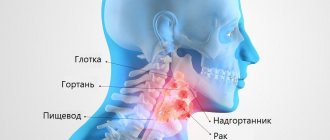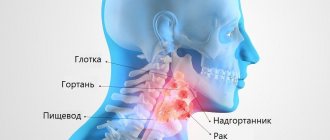Diseases of the throat and oral cavity cause us a lot of discomfort; they are widespread and are diagnosed with enviable frequency in almost every person. Various types of sore throat, be it redness, soreness, stiffness, tingling sensation - all these are symptoms of various diseases of the throat and larynx, which indicate that the throat is inflamed. Medicine distinguishes several types of throat diseases, and all of them are accompanied by the listed symptoms. What diagnoses of throat diseases exist and how do they differ from each other?
Angina
Of all types of throat diseases, sore throat is diagnosed most often, especially in childhood. With this disease, the tonsils are predominantly affected, with other areas of the pharynx and even larynx affected. The cause is often viruses and bacteria, but sometimes a sore throat can manifest itself as a fungal infection of the throat.
The causes of sore throat are hypothermia, decreased immunity and infection from one person to another (especially with viral sore throat), and the presence of a chronic focus of inflammation in the oral cavity.
This type of throat disease should not be taken lightly, as this diagnosis leads to serious complications if not treated promptly. The targets for this throat disease are the kidneys, liver, lymphatic system, musculoskeletal system and even the heart.
Benign tumors
Benign tumors are non-infiltrative growing neoplasms.
They are not prone to metastasize. However, due to the development of mass effect, breathing problems and other unpleasant and life-threatening conditions are possible.
Adenoiditis
Strictly speaking, it is not a benign tumor. Adenoiditis is an inflammation of the adenoids: the enlarged palatine tonsil. Most often have infectious causes.
In almost 100% of cases it affects children under 10 years of age. In adults, the disease occurs as exceptions. This is casuistry.
Symptoms of adenoiditis:
- Nasal breathing disorders. The patient cannot breathe normally due to the overlap of the choanae and vomer.
- Rise in body temperature to subfebrile-febrile levels.
- Symptoms of general intoxication of the body.
Treatment in most cases is surgical. It is necessary to remove the adenoids and thereby the problem will be solved radically.
Other neoplasms
There is also the following list of benign tumors of the larynx and throat:
- Fibroids. Consist of fibrous tissue. They develop mainly in the area of the vocal cords. They have an oval or spherical regular shape. They are not prone to metastasis and grow extremely slowly. Lead to voice changes and breathing problems. Large sizes pose a danger to life and health.
- Lipomas. Also called wen. Develop from adipose tissue. They have a spherical shape. May have a leg. Formation occurs at the entrance to the larynx in most cases.
- Polyps. A type of fibroids. Unlike the former, they have a tendency to malignant degeneration. They need to be removed in any case. This is an axiom.
- Chondromas. Tumors of the larynx from cartilaginous tissue. Over time, they can transform into cancer (chondrosarcoma).
- Papillomas. They're warts. They are provoked by the human papillomavirus. Many strains are oncogenic, therefore mandatory histological examination and PCR diagnostics are required.
- Cystic formations. Fluid structures surrounded by a fibrous capsule. Not prone to growth.
- Angiomas. Vascular tumors. Difficult to remove. They are often congenital.
Important:
In all cases, the reasons for the development of tumors lie in a violation of cell differentiation (the process of transforming unspecialized embryonic cells into specialized cells of tissues and organs) and an increase in their proliferation (the process of cell reproduction).
Treatment is surgical. However, you shouldn’t rush to extremes right away.
The best option would be dynamic monitoring of the tumor. If it grows, it needs to be removed. It is also important to determine the histological structure of the neoplasm (benign or malignant). Only after this do they decide on treatment tactics.
Tonsillitis and its features
Tonsillitis is also a common type of throat disease. The acute form of this pathology is more often called tonsillitis, and the chronic course is characterized by sluggish inflammation of the tonsils. The cause of such a throat disease as tonsillitis is most often bacteria (staphylococcus), and the frequency of exacerbations and the intensity of inflammation depends solely on the resistance of the immune system.
The development of tonsillitis can be caused by diseases such as scarlet fever (red tonsils, crimson tongue, rash on the body with a small dot), mononucleosis (tonsils, liver, spleen are significantly enlarged, monocytes are increased in the blood test), enterovirus infection (dyspeptic disorders, fever body).
Examination, the appearance of the sore throat and the patient’s complaints are usually sufficient symptoms to make a diagnosis. If necessary, the issue of taking a smear from the throat mucosa for bacteriological examination is decided.
What does the doctor think?
“In patients with chronic tonsillitis, tonsillitis occurs 10 times more often than in practically healthy people.”
Sore throat - symptoms and treatment
The incubation period is up to 2 days. The beginning is acute.
Syndromes:
- general infectious intoxication;
- tonsillitis (acute, purulent);
- anglemaxillary lymphadenitis.
Fever, chills and general fatigue
The first signs of a sore throat are an increase in body temperature to 38-40°C, chills, weakness and sweating. Fever of a constant type. Heart rate corresponds to body temperature. The skin of the face is hyperemic, the eyes are shiny.
Headaches and muscle aches
With a sore throat, a headache appears (dull, without clear localization) and severe aches in the muscles and joints.
Sore throat
On the first day of the disease, sore throat appears when swallowing, then becomes a permanent manifestation and can radiate to the ear.
Enlarged and painful lymph nodes
The maxillary lymph nodes enlarge, become very painful, have a dense elastic consistency, and are not fused to each other and the surrounding tissues.
The data obtained during pharyngoscopy are very characteristic:
- mouth opening is free;
- the palatine arches, uvula, tonsils and soft palate are clearly hyperemic in the first days.
Main manifestations of tonsillitis
Enlargement and redness of the tonsils. The tonsils are swollen, red (“juicy”), which corresponds to catarrhal tonsillitis. Usually this stage of the disease is not recognized (they do not have time) and bright visualization occurs on the second day of the disease, when white follicles 2-3 mm in size form in the tonsil tissue, rising above the surface of the tonsil tissue - follicular tonsillitis develops.
From the third day, a yellow-white discharge (pus) appears in the lacunae - follicular-lacunar tonsillitis.
What does a throat look like with a sore throat?
Further, in severe forms, necrotizing tonsillitis occurs: the tonsils are dark gray in color, after the purulent-necrotic masses are rejected, tissue defects remain.
It must be remembered that purulent plaque in case of tonsillitis does not spread beyond the tonsils, is easily removed, and does not sink in water - the appearance of any other variants of the course is a reason to doubt the diagnosis.[2][3][5][6]
Phlegmonous tonsillitis
Phlegmonous tonsillitis is the most severe form of tonsillitis. It is characterized by the development in the tonsil tissue, often of a unilateral purulent focus without clear boundaries. Intoxication sharply increases, severe pain on the affected side and swelling occurs, and it becomes difficult to open the mouth. The disease requires urgent surgical treatment.
Ulcerative-membranous form of tonsillitis
With the ulcerative-membranous form of tonsillitis, ulcerations occur on the surface of the tonsil tissue, severe pain and plaque, which is easily removed with a spatula.
How does viral and herpes sore throat occur?
“Viral sore throats” have nothing to do with classic streptococcal sore throat. They are only separate syndromes for viral diseases: adenovirus, cytomegalovirus and enterovirus (herpangina) infections and many others. The term “tonsillitis” applies only to diseases caused by group A beta-hemolytic streptococcus. All other inflammations of the tonsil tissue should be called acute or chronic tonsillitis.
For this reason, it is incorrect to distinguish herpetic sore throat, sore throat due to diphtheria , influenza , scarlet fever and infectious mononucleosis .
How does angina occur in children?
In children, the symptoms of sore throat are more pronounced than in adults. Intoxication is more severe, the child is lethargic, refuses to eat, possible abdominal pain, severe headaches, nausea and vomiting.
What symptoms of sore throat should you sound the alarm about?
When to see a doctor:
- when the temperature rises above 37.5 °C;
- severe and painful sore throat;
- severe intoxication;
- soreness of the mandibular lymph nodes.
Features of laryngitis
Types of inflammation of the throat include laryngitis, which occurs in acute or chronic form. The diagnosis of this throat disease itself is rarely made; it manifests itself against the background of influenza, ARVI, scarlet fever, whooping cough, etc. Hypothermia, prolonged singing, oratory, smoking - all this becomes a provoking factor for the occurrence of laryngitis.
The distinctive symptoms of laryngitis are a dry cough at the beginning, dry mucous membranes, soreness and hoarseness of the voice. In more complex cases, the voice may disappear completely. On the 3-4th day, the sputum begins to disappear, the cough becomes periodically wet, but more often it is still dry. Upon visual examination (laryngoscopy), swelling and hyperemia of the mucous membranes are clearly visible.
Treatment is prescribed by a doctor, taking into account the nature of the throat disease, but patients should definitely refrain from drinking hot drinks, smoking, and try not to talk, much less scream or sing.
Chronic laryngitis is associated with atrophic or hypertrophic changes in the mucous membranes, although various types of throat infections are often the causes. In any case, the first symptom of laryngitis is a hoarse, barely audible voice.
Malignant tumors
Cancers of this location are relatively rare. However, they are extremely dangerous. In a similar arrangement, carcinomas and sarcomas are distinguished.
Carcinoma
Develops from epithelial tissues. Cell differentiation is practically absent, proliferation is maximum.
The reasons for the development of an oncological tumor are as follows:
- Tobacco abuse. The more a person smokes, the greater the risk of developing carcinoma. When consuming tobacco products a pack a day or more, the likelihood of developing cancer increases by 70%. A person drives himself into harsh conditions.
- Excessive consumption of alcoholic beverages. Burns of the mucous membranes form. As a result, the risks increase significantly.
- Occupational hazards. This includes dangerous work at chemical plants, in hot industries, etc.
- Drinking hot liquids on a regular basis.
Symptoms of throat cancer are as follows:
- Headaches in the back of the head.
- Pain in the jaws, radiating to the teeth.
- Problems with vision and hearing.
- Frequent otitis of unknown origin.
- Voice disorders.
- Bad breath.
Treatment is exclusively surgical. In later stages, radiation and chemotherapy will be required. The choice of treatment tactics is chosen only by the oncologist.
Read more about throat cancer here.
Sarcoma
A much more aggressive tumor. It develops for the same reasons. Characterized by intense cellular atypia and high proliferation rate.
Symptoms are similar to carcinoma and include the following manifestations:
- Toothache.
- Pain in the jaw area on the affected side.
- Voice problems. It becomes weak, hoarse or too low.
- Visual and hearing impairments.
- Frequent otitis.
Treatment, as in the previous case, is surgical. Excision of tissue is required, as radical as possible. This way you can avoid relapses.
Radiation and chemotherapy are prescribed based on the stage of the pathological process.
Pharyngitis
Pharyngitis is one of those types of throat diseases that rarely occur in isolated form. More often it is a consequence of influenza, ARVI or other infectious diseases of the upper respiratory tract. Pharyngitis can develop on its own with prolonged smoking and bad habit abuse, or prolonged inhalation of cold air, i.e. when the irritant acts directly on the mucous membrane of the throat.
A throat disease such as pharyngitis is distinguished by the appearance of a feeling of rawness in the throat, while severe pain is usually absent. Painful sensations appear mainly when swallowing saliva. The temperature with pharyngitis is usually low-grade, and the patient’s general condition suffers slightly.
We have looked at what types of throat diseases there are: the types of sore throat can be different, but timely treatment, including effective medications for the treatment of throat diseases, helps prevent complications and eliminate all unpleasant symptoms!
Diagnosis of throat cancer
Stage 1 throat cancer is diagnosed very rarely due to its small size, up to about 0.5-1 cm. Provided there is no damage to the lymph nodes, about 80% of patients live another 5-6 years. The effectiveness of treatment for laryngeal cancer depends on timely access to qualified medical care and the quality of examination.
The presence of modern, high-quality diagnostic equipment in the oncology clinic of the Yusupov Hospital makes it possible not only to quickly make an accurate diagnosis, but also to select the optimal treatment regimen.
Early diagnosis of throat cancer in the oncology clinic of the Yusupov Hospital is carried out using:
- endoscopy (laryngoscopy and tracheoscopy);
- taking smears and tissue biopsies;
- use of tumor markers.
To clarify the diagnosis, use:
- ultrasound diagnostics - helps to examine the condition of deep lymph nodes and detect possible compression of large vessels;
- computer, magnetic resonance and positron emission tomography (CT, MRI, PET) - determine the size of the tumor and the presence of metastases.
If it is necessary to assess the extent of tumor spread, an X-ray examination of the paranasal sinuses, bone structures, and thoracic organs is prescribed.











